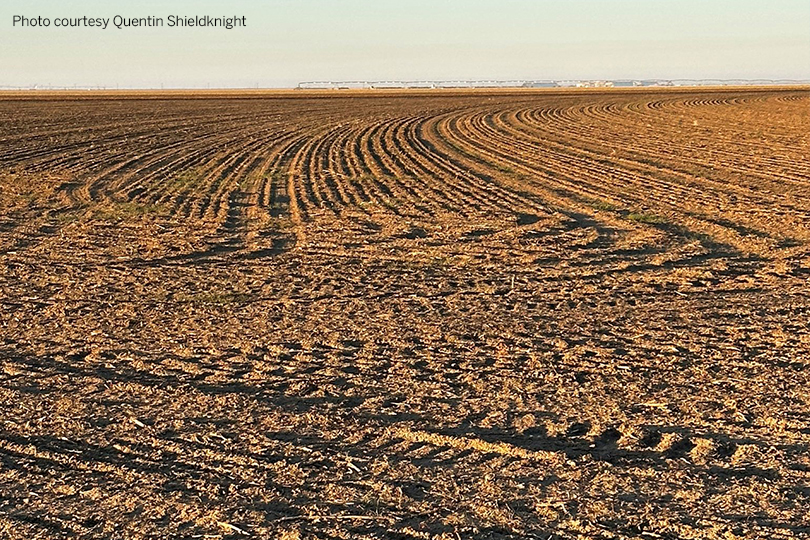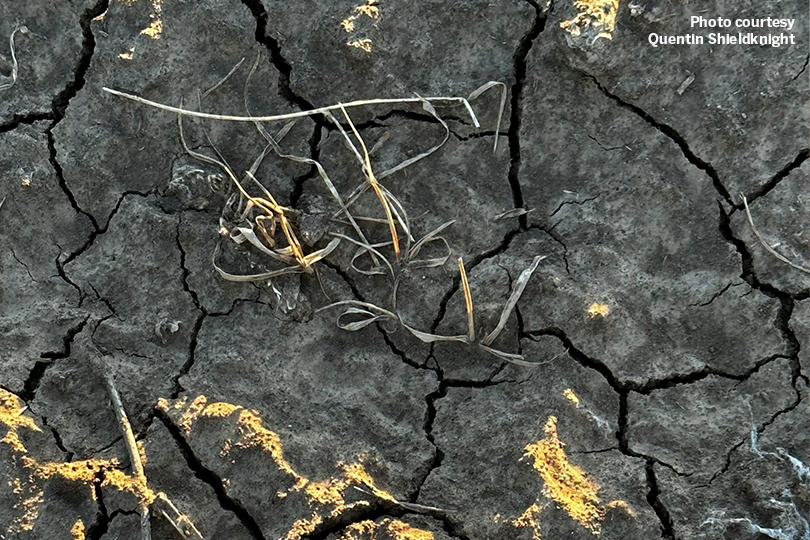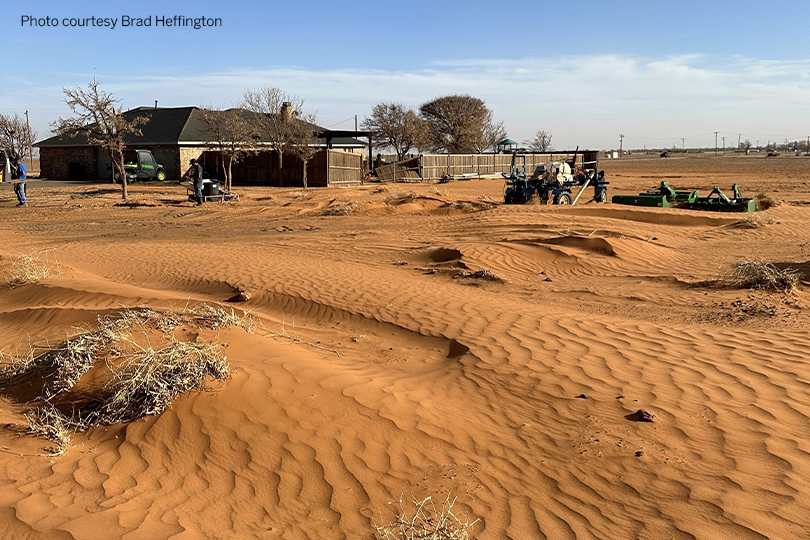By Julie Tomascik
Editor
The Panhandle and South Plains were blanketed in a thick layer of dust kicked up by powerful winds that reached over 100 miles per hour.
Those brutal winds struck the area on Sunday, Feb. 26, leaving farmers facing large crop losses. The devastation was evident the next morning. Wheat fields that were green are now brown.
Early reports estimate about 80% of the dryland wheat crop could be lost, with portions of irrigated wheat suffering losses, as well.
And after two years of drought, the damaging winds have blown away the opportunity for some farm families to recover despite planning and efforts to prepare for the worst.
Quentin Shieldknight
The blue sky turned a dirty brown hue on Sunday. The intense, gritty sandstorm eerily resembled the Dust Bowl.
“Wind speeds in the area were 70 to 114 miles an hour down at Memphis, and then we had some storms come in on the backside, which just kept the wind sustained in that 50-plus mile an hour from 2 p.m. all the way late into the night,” Quentin Shieldknight, a farmer and rancher in Spearman, said.
In his area of the northeast corner of the Texas Panhandle, Shieldknight estimates the majority of the dryland wheat crop is a complete loss.
“If you were lucky enough to have caught a rain and had a summer crop that had some trash and planted wheat in it, those acres may still be hanging on,” he told the Texas Farm Bureau Radio Network. “But it was spotty at best, because our summer rains were so spotty. There’s certain areas that will still have some dryland wheat, but in my particular area, most of it’s gone.”

Shieldkinght has only had 12 inches of rain in two years when the area should have had about 34 inches.
“Thank goodness there’s irrigation here with no till and strip till practices, or we would be looking at a Dust Bowl situation every day,” he said.
It’s not his first wind and sandstorm, and it won’t be his last. But for this time of year, it ranks as one of the worst he’s seen.
“As far as a late winter, early spring windstorm, this one’s going to rank right up there—about as bad as it can get,” he said.

Brad Heffington
North of Littlefield, Brad Heffington said the sandstorm was as bad as he’s seen in his 35 years of farming.
“That’s the worst sandstorm I’ve seen since I was 10 years old back in 1977 that I can remember,” he said in an interview with the Texas Farm Bureau Radio Network.

Straight-line winds eroded lands and sight.
“You couldn’t see across the highway. You couldn’t see where you were going and couldn’t see our yard. It’s horrendous is the only thing I could say,” he said. “Storms in ’11 and ’12 were bad, but not as bad as Sunday. That was a record I think for us as far as the way the sand was blowing and the winds being straight,”
Heffington didn’t have wheat planted, but his forage rye crop suffered major losses. He estimates only a portion of his rye crop might make it.
“It is just not going to have time before it quits growing if it does recover. I’ve really never seen it kill rye, but I’ve seen it burn it so bad it sits there forever and just doesn’t grow and then you have to end up doing something to the land because it’ll start blowing,” he said. But right now, I don’t know if any of it will make it. It’s not all dead, but it’s on life support.”
Laramy Friemel
Laramy Friemel, who farms north of Hereford, isn’t expecting much from his wheat crop.
“On top of a dry year already, our wheat was minimal at best,” he said. “After that windstorm, it pretty well burnt the tops of the wheat off, and I’m almost going to say that the non-irrigated wheat’s pretty well at zero at this point.”
Friemel doesn’t have much hope for his irrigated wheat, either.
“Irrigated wheat was pretty limited from the get-go this year. We knew coming into this winter without rain or snow, what we could irrigate was already cut in half. So, what we’re going for now would be more for seed wheat replacement for next year,” he said. “We’re probably going to irrigate just a little bit for that to keep seed back for next year. And then if by any chance there was a little rain event later this spring, we would maybe try to cut just a little bit of hay off of that, and that would probably be about it.”
Spring outlook
The sandstorm coupled with prolonged drought left the wheat crop especially vulnerable, and it’s changed some farmers’ plans for spring planting.
Some intend to plant more grain crops instead of cotton this year.
And while farmers will salvage what they can and evaluate their spring planting options, they’ll also try to remain optimistic. Because farming anywhere is tough, but especially in the Panhandle and South Plains where dry years are all too common.


not good looks like the early 50’s